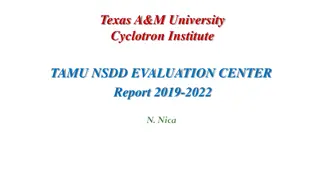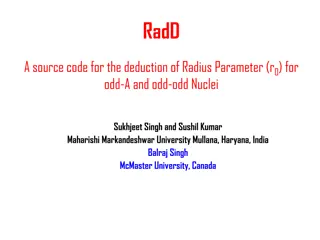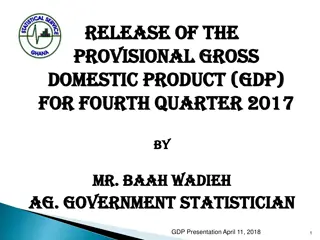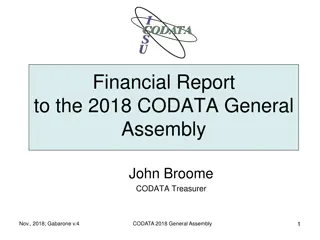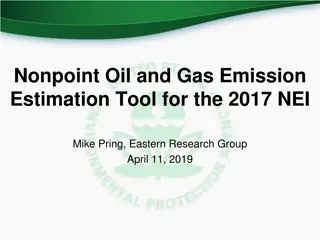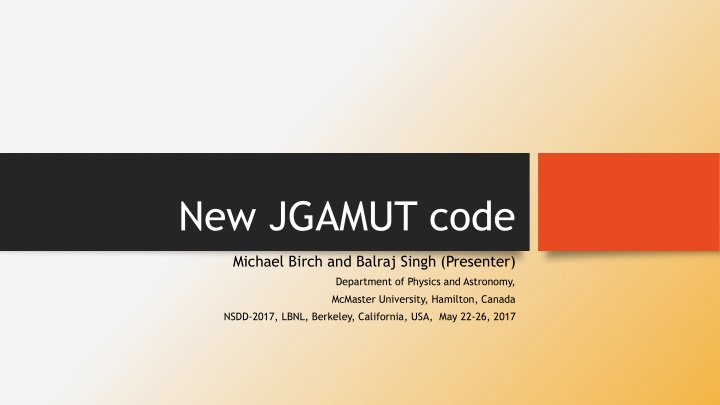
Advanced ENSDF Data Processing Techniques with JGAMUT
Discover how JGAMUT streamlines ENSDF data analysis by automating gamma averaging, detecting discrepancies, and providing statistical procedures. Learn about algorithms, parsing methods, known issues, and mitigation options to enhance data accuracy and efficiency. Stay updated with the latest advancements in nuclear data evaluation.
Download Presentation

Please find below an Image/Link to download the presentation.
The content on the website is provided AS IS for your information and personal use only. It may not be sold, licensed, or shared on other websites without obtaining consent from the author. If you encounter any issues during the download, it is possible that the publisher has removed the file from their server.
You are allowed to download the files provided on this website for personal or commercial use, subject to the condition that they are used lawfully. All files are the property of their respective owners.
The content on the website is provided AS IS for your information and personal use only. It may not be sold, licensed, or shared on other websites without obtaining consent from the author.
E N D
Presentation Transcript
New JGAMUT code Michael Birch and Balraj Singh (Presenter) Department of Physics and Astronomy, McMaster University, Hamilton, Canada NSDD-2017, LBNL, Berkeley, California, USA, May 22-26, 2017
Motivation: Why Use JGAMUT? Current approach for Adopted Levels, Gammas (A-L-G) Manually average gamma-by-gamma for each level Labour intensive, time consuming No standardized procedure for handling systematic discrepancies between different datasets. Using JGAMUT Organizes ENSDF input into an easy to read format (intermediate tabular file) Automates gamma-by-gamma averaging procedure Provides additional routines to detect systematic (calibration) differences between measurements By GAMUT approach, provides sophisticated statistical procedures than simple averaging This code will soon be released through the IAEA-NDS for testing.
JGAMUT Algorithms: Parsing ENSDF Input Input for JGAMUT is a text file containing ENSDF datasets used to make the adopted levels, gammas dataset An important first step is for the code to determine which levels and gammas are the same between different datasets Two or more (closely spaced) levels are considered different if they are from the same dataset (a single level cannot be observed more than once in an experiment) Two levels are considered the same if: Their energies and spins are identical (rarely occurs) Their energies are within 3 keV and there is at least one gamma-ray in common (E within 3 keV; considers both in-coming and out-going gammas)
JGAMUT Algorithms: Parsing ENSDF Input Two gamma-rays are considered the same if they come from different datasets and have the same initial and final levels Initial levels are determined from the ENSDF datasets Final levels (unless specified by FL=) are assigned according to which level is closest in energy to (Ei E ) If difference exceeds 50 keV a warning is given
JGAMUT Algorithms: Parsing ENSDF Input Known issue: tends to produce superfluous levels due to failed matching Options to mitigate the issue: Merge levels with in-coming gammas, but no out-going gammas with near-by levels (since the improperly matched levels often have this property) Only include levels which appear in a given ALG dataset (useful if a nucleus is being updated in ENSDF, but no new levels are being added) The evaluator must always check the intermediate file to ensure level and gamma matching has been done correctly Must also verify each gamma measurement is independent
JGAMUT Algorithms: Gamma-By-Gamma All measurements for each gamma-ray energy and intensity are averaged separately Averaging is done as follows: Weighted average is adopted unless 2> 2crit(at 99% confidence), then Normalized Residual Method (NRM) is adopted unless 2> 2crit(at 99% confidence), then Unweighted average is adopted User is informed if NRM or unweighted average is used
JGAMUT Algorithms: Linear Systematic Shifts Sometimes different experiments have systematic energy discrepancies due to calibration differences The evaluator can choose a particular experiment to be the standard and look for linear systematic differences between the standard and the other measurements The linear energy shifts in gamma-ray energies are defined by ?? (1) (?)+ ???? ?+ ?? = ?? ? ?is the measurement of the i-th gamma-ray energy in the (?)is the measurement in the j-th dataset Where ?? standard dataset and ??
JGAMUT Algorithms: GAMUT E Algorithm Level scheme fitting approach with optional constant systematic shifts formulated by R.B. Firestone (LBNL) [LBL-26024 (1991)] Relate gamma-ray energies to level energies according to ? (5) ?= ?? ????? ? ?=1 Where ?? is the kth level energy, ? is the constant systematic shift for the jth experiment and ???is the placement of the ith gamma with respect to the kth level (+1 or -1 if de-populating or populating, 0 otherwise)
JGAMUT Algorithms: GAMUT I Algorithm Global ?2 minimization procedure by Tepel and Lederer [IAEA report INDC(NDS)-115/NE (1980)] Assumes linear relation between intensity scales of different experiments, ?????= ??, where ??? is the intensity of the ith gamma-ray measured by the jth experiment and ?? is the intensity of the ith gamma-ray on the common scale Factors ?? are determined by minimizing 2 ????? ?? ?2= 2 ?? ??? ? ?
JGAMUT: Adopted Levels and Gammas Program flow Gamma-by- Gamma Averages ENSDF Datasets (input) Intermediate File (user editable) GAMUT Algorithm Results


